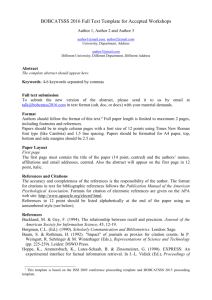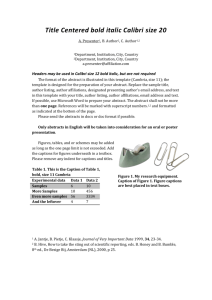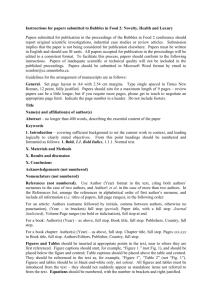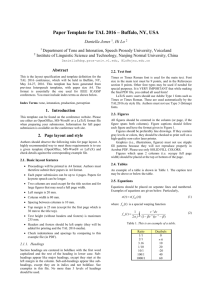Conference Full Paper template
advertisement
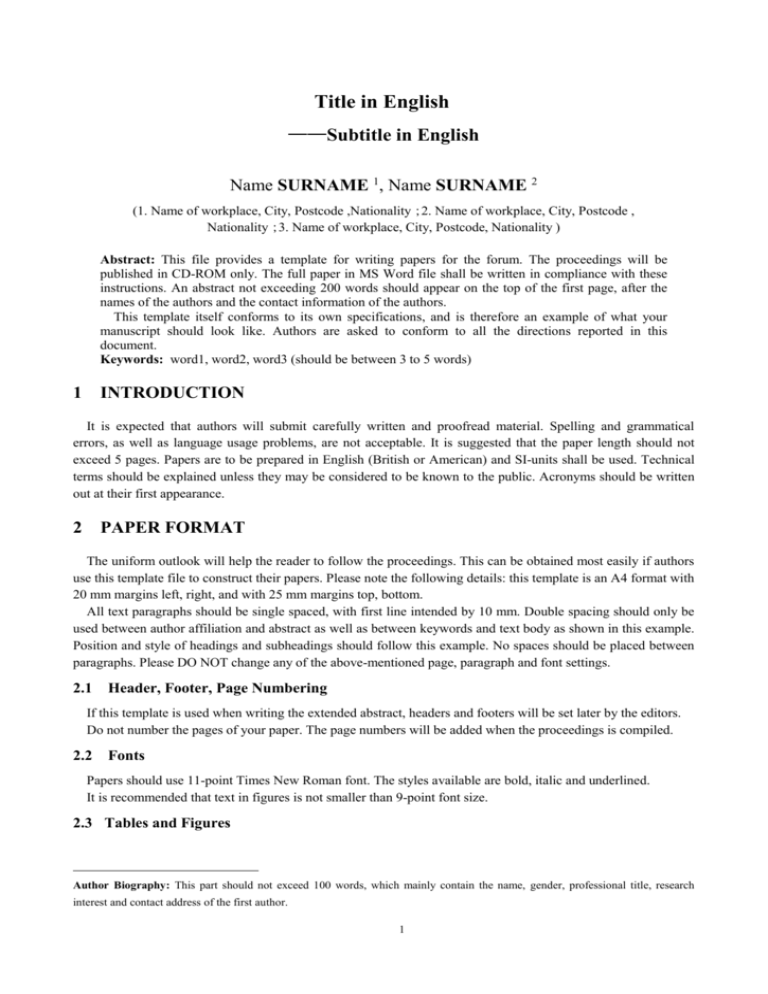
Title in English ——Subtitle in English Name SURNAME 1, Name SURNAME 2 (1. Name of workplace, City, Postcode ,Nationality;2. Name of workplace, City, Postcode , Nationality;3. Name of workplace, City, Postcode, Nationality ) Abstract: This file provides a template for writing papers for the forum. The proceedings will be published in CD-ROM only. The full paper in MS Word file shall be written in compliance with these instructions. An abstract not exceeding 200 words should appear on the top of the first page, after the names of the authors and the contact information of the authors. This template itself conforms to its own specifications, and is therefore an example of what your manuscript should look like. Authors are asked to conform to all the directions reported in this document. Keywords: word1, word2, word3 (should be between 3 to 5 words) 1 INTRODUCTION It is expected that authors will submit carefully written and proofread material. Spelling and grammatical errors, as well as language usage problems, are not acceptable. It is suggested that the paper length should not exceed 5 pages. Papers are to be prepared in English (British or American) and SI-units shall be used. Technical terms should be explained unless they may be considered to be known to the public. Acronyms should be written out at their first appearance. 2 PAPER FORMAT The uniform outlook will help the reader to follow the proceedings. This can be obtained most easily if authors use this template file to construct their papers. Please note the following details: this template is an A4 format with 20 mm margins left, right, and with 25 mm margins top, bottom. All text paragraphs should be single spaced, with first line intended by 10 mm. Double spacing should only be used between author affiliation and abstract as well as between keywords and text body as shown in this example. Position and style of headings and subheadings should follow this example. No spaces should be placed between paragraphs. Please DO NOT change any of the above-mentioned page, paragraph and font settings. 2.1 Header, Footer, Page Numbering If this template is used when writing the extended abstract, headers and footers will be set later by the editors. Do not number the pages of your paper. The page numbers will be added when the proceedings is compiled. 2.2 Fonts Papers should use 11-point Times New Roman font. The styles available are bold, italic and underlined. It is recommended that text in figures is not smaller than 9-point font size. 2.3 Tables and Figures Author Biography: This part should not exceed 100 words, which mainly contain the name, gender, professional title, research interest and contact address of the first author. 1 Figure and table captions, not exceeding 10 altogether, should be sufficient to explain the figure or table without needing to refer to the text. Figures and tables not cited in the text should not be presented. Styles for table and figure captions are available in this template for tables and figures. Do not draw vertical lines in table. Use only three horizontal lines (top and bottom border lines of the table, and a line separating the header and the table contents). The following Table 1 is an example. Table 1 Caption of Example Table Header (Flow control valves) Air operated valves Check valves Line discharge check valves Pump discharge check valves Motor driven pumps Motor driven pumps X 4 2 4 3 2 2 Improved Yes Yes Yes Yes Yes No Tables and figures should be placed close after their first reference in the text. All figures and tables should be numbered with Arabic numerals. Table captions should be centred above the tables. Figure captions should be centred below the figures. Footnotes should be centred below the figure captions. The following Figure 1 is an example. Fig. 1 Verification, Validation and Qualification 2.4 Equations Each equation should be presented on a separate line from the text with a blank space above and below. Equations should be clear and expressions used should be explained in the text. The equations should be numbered consecutively at the outer right margin, as shown in Eq. (1) and (2) below. Here is one example. The number of different ways that a specified component can fail with (k-1) other components in a group of m similar components is: m 1 m 1! k 1 (k 1)!(m k )! 2 (1) Thus, the total failure probability, Qt, of component in a common cause group of m components is: m 1 ( m ) Qk Qt k 1 k 1 m 2.5 (2) References Reference numbers in the text should be designated by square brackets, e.g.,[1]. The references should be listed in the same order as cited in the text and in the order of author, book/magazine name, publishing place, publisher, publishing year, and page numbers. See also examples in the REFERNCES section of this template. 3 CONFERENCE PROGRAMME AND PROCEEDINGS The extended abstracts are compiled into the conference Proceedings. 4 CONCLUSION Conclusions should state concisely the most important propositions of the paper as well as the author’s views of the practical implications of the results. Acknowledgments:(This work was…) REFERENCES [1] International Atomic Energy Agency. Procedures for Conducting Common Cause Failure Analysis in Probabilistic Safety Assessment, IAEA-TECDOC-648, 1992, 111-112. [2] Fleming K N, Rao S B, Tinsley G A, et al. A Database of Common-Cause Events for Risk and Reliability Applications, EPRI TR-100382, Electric Power Research Institute, Paolo Alto, CA., 1992,23-24. [3] Mosleh A, Fleming K N. Procedures for Treating Common Cause Failures in Safety and Reliability Studies, NUREG/CR4780, EPRI NP-5613, Electric Power Research Institute, Paolo Alto, CA., 1998 (1), 1999 (2),8i, 35-36. (责任编辑 3 ***,***)


